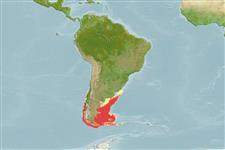Issue
This species is synonym of Macruronus novaezelandiae (Hector, 1871) in Eschmeyer (CofF ver. Jan. 2012: Ref. 89336). Waiting for more confirmation. Please send references or more studies are needed.
Environment: milieu / climate zone / depth range / distribution range
Ecología
marino bentopelágico; oceanodromo (Ref. 51243); rango de profundidad 30 - 500 m (Ref. 1371). Subtropical; 34°S - 60°S, 79°W - 52°W (Ref. 1371)
Southeast Pacific and Southwest Atlantic: off southern Chile and Argentina.
Length at first maturity / Tamaño / Peso / Age
Maturity: Lm ?, range 54 - ? cm
Max length : 115 cm TL macho / no sexado; (Ref. 7063); common length : 80.0 cm TL macho / no sexado; (Ref. 1371); peso máximo publicado: 5.0 kg (Ref. 1371); edad máxima reportada: 19 años (Ref. 122851)
Short description
Claves de identificación | Morfología | Morfometría
Espinas dorsales (total) : 1; Radios blandos dorsales (total) : 100 - 113; Espinas anales: 0; Radios blandos anales: 83 - 90. Dorsal part of body purplish blue, belly silvery with a slight bluish tinge; small melanophores scattered on fin membrane of dorsal and anal fins; inside of mouth blackish (Ref. 1371).
Schooling species which are concentrated on the outer part of the continental shelf (Ref. 1371). Feeds mainly on fish (herring, anchovies, lantern fishes), also on mysids, cephalopods, euphausiids and amphipods (Ref. 1371). Migrates southward in spring and summer and northward in winter (Ref. 1371). Utilized fresh, frozen and for fishmeal (Ref. 1371).
Life cycle and mating behavior
Madurez | Reproducción | Puesta | Huevos | Fecundidad | Larva
Cohen, D.M., T. Inada, T. Iwamoto and N. Scialabba, 1990. FAO species catalogue. Vol. 10. Gadiform fishes of the world (Order Gadiformes). An annotated and illustrated catalogue of cods, hakes, grenadiers and other gadiform fishes known to date. FAO Fish. Synop. 125(10). Rome: FAO. 442 p. (Ref. 1371)
IUCN Red List Status (Ref. 130435: Version 2024-1)
Threat to humans
Harmless
Human uses
Pesquerías: muy comercial
Herramientas
Special reports
Download XML
Fuentes de Internet
Estimates based on models
Preferred temperature (Ref.
123201): 4.5 - 9.7, mean 6.5 °C (based on 311 cells).
Phylogenetic diversity index (Ref.
82804): PD
50 = 0.5625 [Uniqueness, from 0.5 = low to 2.0 = high].
Bayesian length-weight: a=0.00407 (0.00228 - 0.00729), b=2.97 (2.80 - 3.14), in cm total length, based on LWR estimates for this species & (Sub)family-body (Ref.
93245).
Nivel trófico (Ref.
69278): 3.8 ±0.55 se; based on food items.
Resiliencia (Ref.
120179): Bajo, población duplicada en un tiempo mínimo de 4.5-14 años (K=0.09-0.1).
Prior r = 0.28, 95% CL = 0.18 - 0.42, Based on 1 data-limited stock assessment.
Fishing Vulnerability (Ref.
59153): Moderate vulnerability (41 of 100).
Climate Vulnerability (Ref.
125649): High to very high vulnerability (69 of 100).
Nutrients (Ref.
124155): Calcium = 35.8 [16.1, 79.9] mg/100g; Iron = 0.788 [0.361, 1.658] mg/100g; Protein = 17.5 [15.2, 19.7] %; Omega3 = 0.189 [0.091, 0.377] g/100g; Selenium = 60.1 [27.6, 133.1] μg/100g; VitaminA = 12.4 [3.5, 43.2] μg/100g; Zinc = 0.502 [0.326, 0.773] mg/100g (wet weight); based on
nutrient studies.
